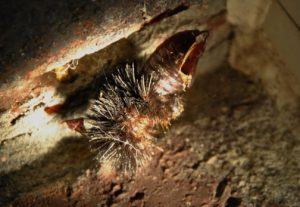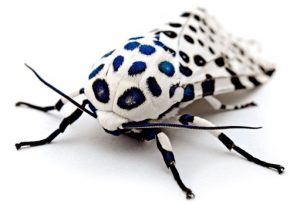 The giant leopard moth or eyed tiger moth is a moth of the family Erebidae. It is distributed throughout the Americas from southern Ontario, and southern and eastern United States through New England, Mexico and down to Panama. The obsolete name Ecpantheria scribonia is still occasionally encountered.
The giant leopard moth or eyed tiger moth is a moth of the family Erebidae. It is distributed throughout the Americas from southern Ontario, and southern and eastern United States through New England, Mexico and down to Panama. The obsolete name Ecpantheria scribonia is still occasionally encountered.
The Giant Leopard Moth caterpillar spends the winter in a state of hibernation, although in more temperate parts of its range it may wake temporarily on mild days for a mid-winter snack. When spring arrives, Giant Leopard Moth caterpillars become active again and feed heavily until the optimal size is reached, at which time each larva shucks off its spiny exoskeleton one more time and makes a pupa. The adult metamorphoses therein and emerges after only a few weeks; thus, the cycle begins again for the Giant Leopard Moth.
 This species has a wingspan of 76 mm (3 in). Wings have a stark white base on which black color rings are visible. The wings of this moth are bright white with a pattern of neat black blotches, some solid and some hollow. The spots on the forewings of adult giant leopard moths may serve as disruptive coloration to make them less conspicuous to predators The side of the abdomen is dark blue with orange markings, while the underside is white with solid black spots, and males have a narrow yellow line on the sides. Its legs have black and white bands. Adult moths are strictly nocturnal and do not generally fly before nightfall.
This species has a wingspan of 76 mm (3 in). Wings have a stark white base on which black color rings are visible. The wings of this moth are bright white with a pattern of neat black blotches, some solid and some hollow. The spots on the forewings of adult giant leopard moths may serve as disruptive coloration to make them less conspicuous to predators The side of the abdomen is dark blue with orange markings, while the underside is white with solid black spots, and males have a narrow yellow line on the sides. Its legs have black and white bands. Adult moths are strictly nocturnal and do not generally fly before nightfall.
Adult giant leopard moths have ears, probably to detect the echolocation sonar of hunting bats allowing them to take evasive action. The ears are located immediately behind the bases of the hind wings. This species has a notable sexual dimorphism in size, the adult male reaching about 51 mm (2 in) in length, while the adult female grows up to 30 mm (1.2 in). Males have borders around the sides of its body and black legs comprise white markings on them. The adults fly during at night but can sometimes be seen resting during the day on tree trunks. The adults are incapable of feeding.
Fortunately, giant leopard moths don’t live very long as they don’t have mouthparts and don’t eat during this stage of their lives. As moths, they basically exist just to lay eggs before passing away. It is because of this short lifespan and its nocturnal habits that many insect enthusiasts rarely catch a glimpse of this month, making the discovery and/or capture of one a pretty big deal for bug lovers.
Giant moth found crawling inside a bag of ‘fresh and washed’ Woolworths spinach
By Alisha Buaya For Daily Mail Australia, PublisheD: 17 November 2016
A customer has found a huge moth crawling inside a bag of spinach.
Woolworths customer Josh Dan found a large moth inside a 120g bag of ‘fresh and washed’ spinach.
He wrote a post to the supermarket’s Facebook page and shared a video showing the bug moving around in the bag.
‘Check out what I found in a bag of spinach I just purchased,’ he wrote.
‘I’ve been disappointed with your “fresh” produce before, but this is taking it a bit far.
The supermarket responded to the customer’s post via private message.
A Woolworths spokesperson told Daily Mail Australia: ‘We take all customer concerns seriously and are investigating the issue.’
Earlier this year a Sydney woman found alive huntsman spider in a bag of Woolworths Italian salad mix.
Freeze moths out of your life: They got her clothes, her carpets, and her curtains… but then author Raffaella Barker got rid of her pests
By Raffaela Barker For The Daily Mail Published: 21 May 2017
No cloth, no cashmere, no carpet is safe from the stealth missile that is the pale-backed clothes moth.
This I found out a few weeks ago, when, humming a little, I went to unwrap my summer wardrobe from its winter home.
Opening the door to our spare bedroom, not much stirred at first. But as I stepped past the bed, a flutter of wings spiraled up from the floor — a single harbinger of the doom that I was still oblivious to.
Such a huge nuisance of this tiny species cannot be neglected. The pesticides and insecticides are proven to be ineffective against them. However, these methods are hazardous methods causing harm to targeted and non-targeted species.
C Tech Corporation can offer an eco-friendly solution to problems from moths. Our product Combirepel™ is a low-toxic, non-hazardous and insect aversive. Our product work on the mechanism of repellence and they do not harm or kill the target species but generate fear or trigger temporary discomfort within the pests that keeps the pests away from the application. The unpleasant experience with our products is imprinted within an animal’s memory and passed on its progeny.
Our product works on the mechanism of repellency. It temporarily inhibits the mating cycle of the insects. The product impairs the ability of the insects to reproduce, that is the insects will not lay eggs or the laid eggs will be infertile. The product causes feeding disruption in an insect by triggering an unpleasant reaction within the insect which might try to feed on the application. The product temporarily blocks the reproduction system of the insects by hindering the release of the vital hormones for growth.
The product available in the form of masterbatch can be incorporated into the base polymer of the polymeric applications like the wires and cables, pipes, household utilities, etc. to keep the pest away from the application.
The product available in the form of liquid concentrate can be mixed in paints and be applied on the interior and exterior of the houses, schools, hospitals, warehouses, offices etc. to keep these areas safe from these pests.
The product available in the form of lacquer form can be used as a direct application. The lacquer can be applied to the already installed applications like the wires and cable, pipes, metal decors, racks and pallets from stores rooms etc.
Combirepel™ is thermally stable and does not degrade on exposure to heat and sunlight. It does not kill or harm the insect but repels them. It does not volatilize and does not degrade the soil. It is RoHS, RoHS2, ISO, REACH, APVMA, NEA compliant and FIFRA exempted.
Contact us at technical.marketing@ctechcorporation.com to keep the pests away.
Also, visit our websites:
http://www.ctechcorporation.com/
http://www.rodrepel.com/
http://www.termirepel.com/
http://www.combirepel.com/
Follow our Facebook pages at:
1] https://www.facebook.com/Combirepel-411710912249274/
2] https://www.facebook.com/Termirepel-104225413091251/
3] https://www.facebook.com/Rodrepel-120734974768048/
Follow us on our Twitter pages at:
1] https://twitter.com/rodrepel
2] https://twitter.com/termirepel
3] https://twitter.com/combirepel
